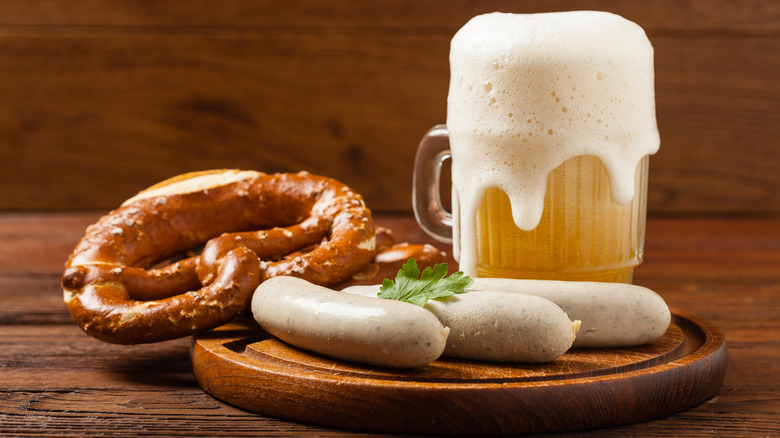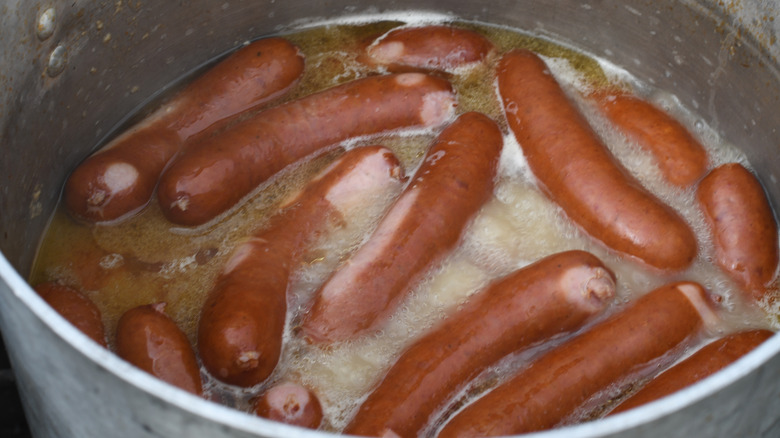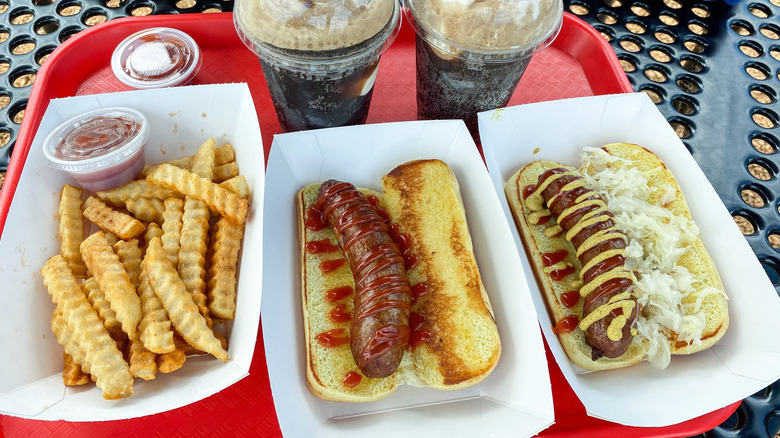How Beer Brats Became The Wisconsin Food Staple They Are Today
During the summer months and early autumn, it's time to get grilling. Besides burgers, there are few grill staples as classic as a sausage — especially bratwurst. From August to October, the legendary Wisconsin delicacy called the beer brat is in its finest form. Consisting of seasoned pork and veal, these sausages are salty, fatty, savory, and perfect when served with an ice-cold beer.
While bratwurst has southern German origins, beer brats in particular are definitely a Wisconsin thing. Various counties and cities claim ownership of this savory sausage treat, but it's a known fact that the state has been churning out beer brats for over 100 years. Usinger is a famous go-to for beer brats, and has been around since the 1880s. Madison's State Street Brats have been offering their unique red brats for beer boiling since the 1950s. Johnsonville, appropriately located in Johnsonville, WI, has been making brats since 1945, though locals will tell you that their sausage isn't the go-to for beer brats.
From selecting the best beer to cook your brats with to acceptable condiments, Wisconsinites have a very specific notion of how this celebrated dish should be served. That's because there's tradition, community, and an illustrious history all tied into this midwestern delight.
Where beer brats come from
You might think, because bratwursts originally come from Germany, a place also known for its beer, that Germans were the ones to dream up beer brats. Shockingly, that isn't the case, and the honor instead belongs to the state that also makes the most cheese, Wisconsin. In 1848, Wisconsin became a state at the same time as an influx of immigrants from battle-worn Germany. Wisconsin also had a growing brewery industry, thanks in part to the high number of lumberjacks who wanted something comfy to drink after a long day of work. We don't know what individual first plopped some brats into beer, but it's pretty easy to see how they'd come up with the idea.
In the 1920s, beer brats began to appear regularly in restaurants and at family homes alike in the Sheboygan area. They became so popular that when Milwaukee County Stadium opened 60 miles away in 1953, folks there took notice. In 1954, food vendor Bill Sperling began serving Sheboygan-style beer brats at all major league baseball games played in the park. This was the spark that lit the beer brat fire throughout the state, and it quickly spread, even beyond Wisconsin's borders to the rest of the Midwest. It's no wonder, then, that Sheboygan is still known as the bratwurst capital of the world! Nowadays, they hold a massive Brat Days festival, which they started in 1953, to celebrate their sausage heritage. Madison also holds a huge bratwurst festival of their own, as do several other cities across the state.
Following the brat rules isn't exactly easy
Given that they brought this dish to power, it makes sense that Wisconsonites have a lot of rules when it comes to brats. These rules rarely agree, however, leading to some confusion and argument. Some say that you should only boil in beer you'd be willing to drink. Others say it should be the skunkiest, cheapest beer imaginable. Some swear by German beers, giving credit to the sausage's German roots. Others say only local beers will do, such as Schlitz, due to the beer's malty flavor and Milwaukee origins. One thing they all seem to agree on is that before they hit the grill, give your brats a boil in beer of your choice with some onions. That way, you'll get a good snap to the skin with a juicy interior.
Condiments are a whole other matter, though, especially depending on what region you're in. Most Wisconsinites say that the brats should be served in a roll rather than a hot dog bun, with warm sauerkraut, flavorful mustard, and maybe grilled onions or pickles. Other additions, such as cheese, ketchup, onions, and peppers, are still hotly debated. So, if you happen to find yourself in the Badger State with a brat in hand, maybe ask your host or server how they like it in order to get the most authentic experience.


